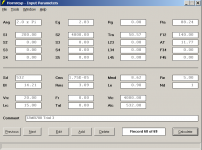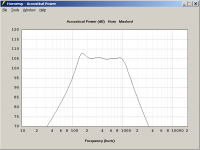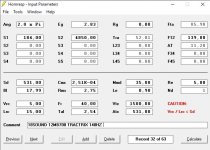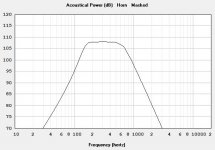Thanks for your comments ICG, you have some good points.
Not a dedicated chamber no, but the air volume in front of the cone will act as a compression chamber. This will be approximately 2 litres for a typical 12" driver. To get rid of this, they would have to use a phase plug, which they aren't to my knowledge. The one integrated in the driver is very small and doesn't displace more volume than a typical dust cap.
But does the VAS really matter in this application? You would need a big box if you wanted to use this driver in a BR or sealed box for low bass response. The rear chamber in a horn system has a different task if I'm not mistaken; reactance annulling. Tuning it to the flare frequency of the horn. Meaning that you actually want a resonance in the lowest part of the range.
Also, I think you got the Qts value from the field coil version of this driver. (This is the value for the lowest voltage (6V), for 12V the Qts is 0,21.)
I'm looking at the permanent magnet version.
Very true 🙂
Both do not use a compression chamber.
Not a dedicated chamber no, but the air volume in front of the cone will act as a compression chamber. This will be approximately 2 litres for a typical 12" driver. To get rid of this, they would have to use a phase plug, which they aren't to my knowledge. The one integrated in the driver is very small and doesn't displace more volume than a typical dust cap.
[*]Very high VAS (154l), Qts (0,64), the back chamber has to be BIG
[*]High fs (60Hz). Combined with the high VAS and Qts the resonance quickly rises into the horn range, which causes a huge decay ridge.
But does the VAS really matter in this application? You would need a big box if you wanted to use this driver in a BR or sealed box for low bass response. The rear chamber in a horn system has a different task if I'm not mistaken; reactance annulling. Tuning it to the flare frequency of the horn. Meaning that you actually want a resonance in the lowest part of the range.
Also, I think you got the Qts value from the field coil version of this driver. (This is the value for the lowest voltage (6V), for 12V the Qts is 0,21.)
I'm looking at the permanent magnet version.
In acoustics, there's no such thing as 'free lunch'.
Very true 🙂
Last edited:
Not a dedicated chamber no, but the air volume in front of the cone will act as a compression chamber. This will be approximately 2 litres for a typical 12" driver. To get rid of this, they would have to use a phase plug, which they aren't to my knowledge. The one integrated in the driver is very small and doesn't displace more volume than a typical dust cap.
Yes, the PP of the driver isn't any effective there. I doubt the 2 liter though. The point is, they don't get reflections from the compression chamber because there are no edges or surfaces to reflect on.
But does the VAS really matter in this application?
Actually, it does. It determines the Qt.
You would need a big box if you wanted to use this driver in a BR or sealed box for low bass response. The rear chamber in a horn system has a different task if I'm not mistaken; reactance annulling. Tuning it to the flare frequency of the horn. Meaning that you actually want a resonance in the lowest part of the range.
No, you don't. Except for the bass, you want to strictly avoid to get the resonance within the used frequency range. The phase turn, huge decay delay and interference with the xo (even with a dsp since the phase is there still a problem) are all things you definitely do not want in the midrange. In the bass you can get away with it because the ear is there really insensitive to phase changes (unless you got interferences which give a bump or dip) and you are dependent on the spl increase, aside from the fact you'd have serious problems to create a driver with the needed parameters in the first place, I don't know if such a bass driver is actually possible.
The one thing is the reactance, that's a whole complete debate, which we don't need to discuss here. The other thing is, a already very high Qts will reach a much, MUCH higher value if the back chamber is too small. A high Q-factor introduces overswing and you don't want that either.
Also, I think you got the Qts value from the field coil version of this driver. (This is the value for the lowest voltage (6V), for 12V the Qts is 0,21.)
I'm looking at the permanent magnet version.
I'm afraid you are right, sorry for that. loudspeakerdatabase says it's much higher but with 0,31 it's still not an issue. The Audiophonics shop says 0,32. Okay, let's scratch that off the list. Unfortunately, there are still way too much compromises to take unless your personal preferences fit to exactly the remaining advantages. Especially at that price.
Here are the HornResp Simulations I ran for the 12MB700.
The 12MB700 got a BL of 17,8 and not 14,21 and I find it very hard to believe the Mmd or the Mms is just 8,62g since it got a massive 75mm coil. 18s says its Mms is 41g instead. The Cms is 0,254mm/N so that's not correct either. The SD is stated with 531cm² (which will make hardly a difference, not the specs of the driver anyway). How about you use the actual parameters? 😡
The point is, they don't get reflections from the compression chamber because there are no edges or surfaces to reflect on.
Are reflections in the compression chamber relevant below 500hz with the minimum wavelength being 69cm? Seems odd, but asking since I don't know.
I don't see much correlation between driver VAS and rear chamber volume in Hornresp, among 12" drivers I have simulated the optimal volume varies between 4 and 6 litres.
I have attached the correct data for the 12MB700 in my 140hz Tractrix horn.
I have simulated ALOT of 12" drivers in Hornresp, and the 12MB700 seems to fit this particular horn the best. 107dB sensitivity 160-600hz.
Attachments
A tractrix horn can cause the driver motor to be a more significant factor.I don't see much correlation between driver VAS and rear chamber volume
A tractrix horn can cause the driver motor to be a more significant factor.
Thanks Allen!
- Status
- Not open for further replies.
- Home
- Loudspeakers
- Multi-Way
- Driver selection for 1st order crossover



